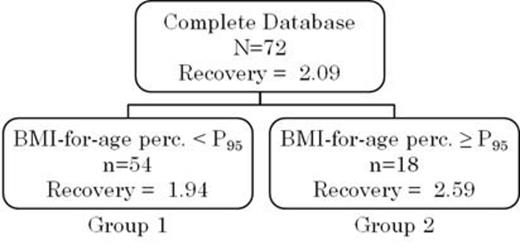Abstract

Introduction: The treatment of hemophilia A (HA) requires infusions of factor VIII (FVIII) concentrates. The number of FVIII units infused in order to obtain a specific circulating FVIII level is calculated with the formula: [body weight (BW) (kg) × desired FVIII increase (%)] / 2, with the assumption that each unit of FVIII infused per kg of BW increases the circulating FVIII level by 2 % 1. The aim of the present study was to evaluate the impact of several morphometrical parameters (BW, body mass index (BMI), BMI-for-age, fat mass index (FMI), height), age and type of coagulation factor concentrate on the FVIII recovery in a large group of children with severe haemophilia A who had previously taken part in pharmacokinetic studies using Advate®, Kogenate FS® or ReFacto AF/Xyntha®.
Methods: A total of 72 children aged between 6 and 17 with severe HA carefully selected from 7 pharmacokinetic clinical trials using three recombinant FVIII concentrates were included in the analysis. The FVIII recovery was calculated using the maximum FVIII concentration measured at 15 and 30 minutes after infusion. Regression tree (RT) was used to identify predictors of FVIII recovery. RT-based models are non-linear and non-parametric alternatives to linear models for regression problems 2.
Results: The median age was 14.5 years with a median FVIII recovery of 2.09 for all patients. The median FVIII recovery was not significantly different between the 3 coagulation factor groups (p=0.542) but was significantly different between BMI-for-age percentiles groups (p<0.001) with a median FVIII recovery of 1.53, 1.93, 2.15 and 2.59 for underweight, normal, overweight and obese children, respectively (Fig. 1). The median age was similar in these 4 groups (p=0.930). In multivariate analysis, 2 groups were created by RT (Fig. 2): patients with a BMI-for-age percentile < P95 (Group 1; Median [P25; P75] FVIII recovery: 1.94 [1.57; 2.21]) and patients with a BMI-for-age percentile ≥ P95 (Group 2; Median [P25; P75] FVIII recovery: 2.59 [2.39; 2.75]). The FVIII recovery was significantly different between these two groups (P<0.001) (Fig. 3).
Conclusions: The BMI-for-age emerged as the strongest predictor of FVIII recovery in children aged between 6 and 17, with a cut-off value at the 95th percentile. Our findings support that dose calculation of FVIII to reach a specific FVIII target level should be adapted in overweight children since only a small fraction of FVIII distributes outside the vascular system 6. These results are consistent with previous studies conducted in adults with HA 4;5, and confirm that the long-held and current practice of applying an arbitrary and universal recovery of 2 to the calculations of FVIII dosage should be abolished.
Regression tree representing the important predictors for FVIII recovery. The selected splitting variables (BMI-for-age perc. = body mass index-for-age percentile) are shown in the nodes. Recovery : median FVIII recovery
Regression tree representing the important predictors for FVIII recovery. The selected splitting variables (BMI-for-age perc. = body mass index-for-age percentile) are shown in the nodes. Recovery : median FVIII recovery
Scatter plot of FVIII recovery in function of BMI-for-age percentile. All the groups created by regression tree are shown in the figure.
Scatter plot of FVIII recovery in function of BMI-for-age percentile. All the groups created by regression tree are shown in the figure.
References
1. Ingram GI. Calculating the dose of factor VIII in the management of haemophilia. Br J Haematol 1981;48:351-354.
2. Speybroeck N. Classification and regression trees. Int.J.Public Health 2012;57:243-246.
3. Linderkamp O, Versmold HT, Riegel KP, Betke K. Estimation and prediction of blood volume in infants and children. Eur.J.Pediatr. 1977;125:227-234.
4. Henrard S, Speybroeck N, Hermans C. Body weight and fat mass index as strong predictors of factor VIII in vivo recovery in adults with hemophilia A. J.Thromb.Haemost. 2011;9:1784-1790.
5. Henrard S, Speybroeck N, Hermans C. Impact of being underweight or overweight on factor VIII dosing in hemophilia A patients. Haematologica 2013;98:1481-1486.
6. Björkman S, Berntorp E. Pharmacokinetics of coagulation factors. Clinical relevance for patients with haemophilia. Clin Pharmacokinet 2001;40:815-832.
No relevant conflicts of interest to declare.
Author notes
Asterisk with author names denotes non-ASH members.

This icon denotes a clinically relevant abstract




This feature is available to Subscribers Only
Sign In or Create an Account Close Modal